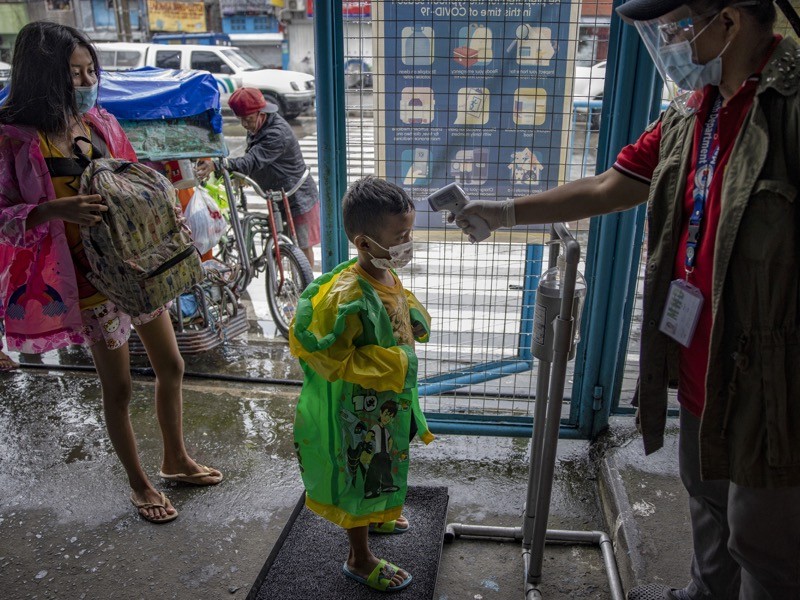How Do You Know if You Asymptomatic
How many people don't experience whatsoever symptoms after becoming infected with SARS-CoV-two? And what is their role in spreading COVID-nineteen? These take been fundamental questions since the beginning of the pandemic.
Now, evidence suggests that about one in five infected people volition experience no symptoms, and they will transmit the virus to significantly fewer people than someone with symptoms. But researchers are divided about whether asymptomatic infections are interim equally a 'silent driver' of the pandemic.
Although at that place is a growing understanding of asymptomatic infections, researchers say that people should keep to use measures to reduce viral spread, including social distancing and wearing masks, regardless of whether they accept symptoms.
The result with putting a reliable figure on the charge per unit of asymptomatic COVID-nineteen is distinguishing betwixt people who are asymptomatic and pre-symptomatic, says Krutika Kuppalli, an infectious-disease researcher at the Medical Academy of Due south Carolina in Charleston. "Asymptomatic is someone who never developed symptoms ever throughout the class of their disease, and pre-symptomatic is somebody who has mild symptoms before they do go on to develop symptoms," Kuppalli says. There is besides no standardized accustomed definition of that, she says.
Enquiry early in the pandemic suggested that the rate of asymptomatic infections could exist as high as 81%. But a meta-analysis published last monthone, which included 13 studies involving 21,708 people, calculated the rate of asymptomatic presentation to exist 17%. The analysis defined asymptomatic people as those who showed none of the key COVID-19 symptoms during the entire follow-up menstruum, and the authors included only studies that followed participants for at least seven days. Evidence suggests that most people develop symptoms in 7–thirteen days, says lead writer Oyungerel Byambasuren, a biomedical researcher at the Plant for Evidence-Based Healthcare at Bail Academy in Gold Coast, Commonwealth of australia.
Silent reservoir
Byambasuren'southward review also found that asymptomatic individuals were 42% less probable to transmit the virus than symptomatic people.
1 reason that scientists want to know how frequently people without symptoms transmit the virus is because these infections largely get undetected. Testing in near countries is targeted at those with symptoms.
As part of a big population study in Geneva, Switzerland, researchers modelled viral spread among people living together. In a manuscript posted on medRxiv this month2, they study that the chance of an asymptomatic person passing the virus to others in their home is about ane-quarter of the risk of manual from a symptomatic person.
Although at that place is a lower gamble of transmission from asymptomatic people, they might still present a significant public-health run a risk because they are more than likely to exist out in the customs than isolated at home, says Andrew Azman, an infectious-illness epidemiologist at the Johns Hopkins Bloomberg School of Public Wellness in Baltimore, Maryland, who is based in Switzerland and was a co-author on the study. "The actual public-health burden of this massive pool of interacting 'asymptomatics' in the customs probably suggests that a sizeable portion of manual events are from asymptomatic transmissions," he says.
Just other researchers disagree about the extent to which asymptomatic infections are contributing to customs transmission. If the studies are correct in finding that asymptomatic people are a depression manual adventure, "these people are not the hush-hush drivers of this pandemic", says Byambasuren. They "are not coughing or sneezing as much, they're probably not contaminating every bit much surfaces every bit other people".
Muge Cevik, an infectious-disease researcher at the University of St Andrews, UK, points out that because well-nigh people are symptomatic, concentrating on identifying them will probably eliminate most transmission events.
Viral dynamics
To understand what is happening in people with no symptoms, Cevik and colleagues conducted a systematic review and meta-analysis3 of 79 studies on the viral dynamics and transmissibility of SARS-CoV-2, which is posted on social-sciences preprint server SSRN. Some studies showed that those without symptoms had similar initial viral loads — the number of viral particles nowadays in a pharynx swab — when compared with people with symptoms. Just asymptomatic people seem to clear the virus faster and are infectious for a shorter period.
The immune systems of asymptomatic individuals might be able to neutralize the virus more apace, says Cevik. Only that doesn't mean these people take a stronger or more durable immune response — and there is evidence that people with astringent COVID-nineteen have a more substantial and long-lasting neutralizing antibody response, she says.
Although at that place is a at present a better agreement of asymptomatic infections and transmission of COVID-19, Cevik says that asymptomatic people should proceed to use measures that reduce viral spread, such every bit social distancing, paw hygiene and wearing a mask.
Updates & Corrections
-
Correction 20 November 2020: A previous version of this story incorrectly stated that studies analyzed in the Cevik, M. et al meta-analysis had measured viral particles in the blood. Particle numbers were measured in throat swabs.
-
Correction 23 November 2020: This article has been updated with the correct affiliation for Krutika Kuppalli.
References
Source: https://www.nature.com/articles/d41586-020-03141-3

0 Response to "How Do You Know if You Asymptomatic"
Post a Comment